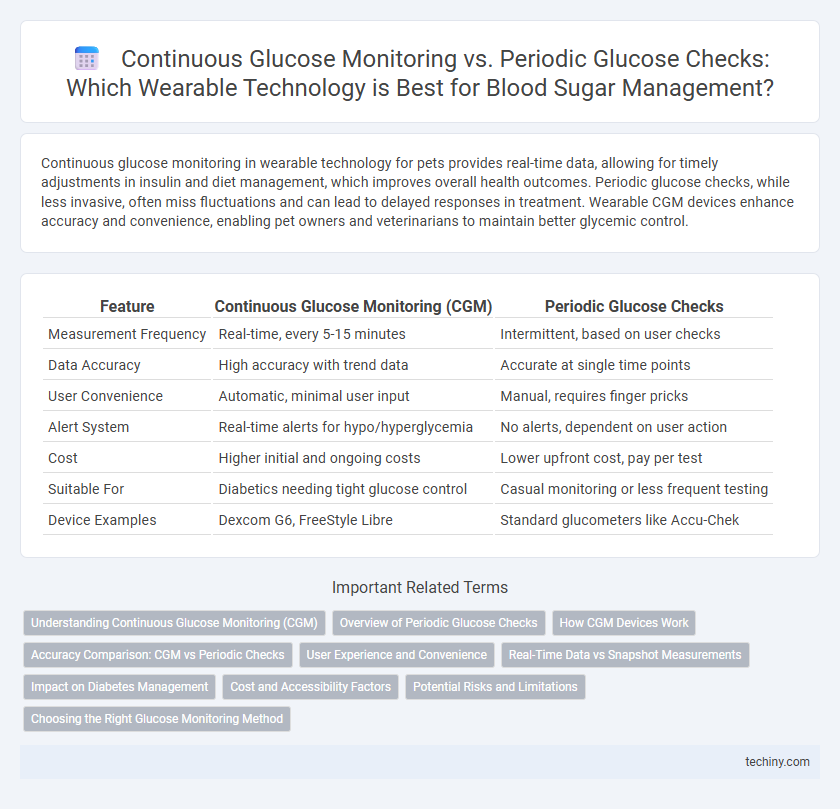Continuous glucose monitoring in wearable technology for pets provides real-time data, allowing for timely adjustments in insulin and diet management, which improves overall health outcomes. Periodic glucose checks, while less invasive, often miss fluctuations and can lead to delayed responses in treatment. Wearable CGM devices enhance accuracy and convenience, enabling pet owners and veterinarians to maintain better glycemic control.
Table of Comparison
| Feature | Continuous Glucose Monitoring (CGM) | Periodic Glucose Checks |
|---|---|---|
| Measurement Frequency | Real-time, every 5-15 minutes | Intermittent, based on user checks |
| Data Accuracy | High accuracy with trend data | Accurate at single time points |
| User Convenience | Automatic, minimal user input | Manual, requires finger pricks |
| Alert System | Real-time alerts for hypo/hyperglycemia | No alerts, dependent on user action |
| Cost | Higher initial and ongoing costs | Lower upfront cost, pay per test |
| Suitable For | Diabetics needing tight glucose control | Casual monitoring or less frequent testing |
| Device Examples | Dexcom G6, FreeStyle Libre | Standard glucometers like Accu-Chek |
Understanding Continuous Glucose Monitoring (CGM)
Continuous Glucose Monitoring (CGM) uses a small sensor inserted under the skin to provide real-time glucose readings every few minutes, offering precise insights into glucose trends and patterns. Unlike periodic glucose checks that require finger pricks at specific times, CGM delivers continuous data to a smartphone or receiver, enabling proactive glucose management. This technology significantly improves diabetes control by alerting users to rapid glucose fluctuations, thus reducing the risk of hyperglycemia and hypoglycemia.
Overview of Periodic Glucose Checks
Periodic glucose checks involve measuring blood sugar levels at specific intervals using finger-prick glucometers, providing discrete data points rather than continuous trends. This method requires manual testing multiple times a day, which can lead to gaps in glucose monitoring and less comprehensive management of glycemic fluctuations. Despite its limitations, periodic glucose checks remain a cost-effective and widely accessible option for many individuals managing diabetes.
How CGM Devices Work
Continuous Glucose Monitoring (CGM) devices use a small sensor inserted under the skin to continuously measure glucose levels in interstitial fluid, transmitting real-time data to a connected device or smartphone. These sensors update glucose readings every few minutes, allowing users to track trends and detect fluctuations without the need for fingerstick tests. Unlike periodic glucose checks that provide singular data points, CGM offers comprehensive and dynamic glucose profiles essential for proactive diabetes management.
Accuracy Comparison: CGM vs Periodic Checks
Continuous Glucose Monitoring (CGM) systems provide real-time, dynamic glucose readings with high accuracy through subcutaneous sensors, offering up to 96 glucose measurements per day compared to periodic glucose checks taken at discrete intervals. Studies indicate CGMs reduce measurement errors by capturing glucose trends and hypoglycemic events that periodic fingerstick tests often miss, enhancing overall diabetes management. While periodic checks rely on single-point readings affected by timing and user technique, CGM data delivers consistent, contextual glucose patterns crucial for precise treatment adjustments.
User Experience and Convenience
Continuous Glucose Monitoring (CGM) systems provide real-time, automated glucose readings through wearable sensors, significantly enhancing user convenience by eliminating the need for frequent finger pricks. Periodic glucose checks require manual testing with a glucometer, which can be disruptive and less convenient, especially for active users or those needing frequent monitoring. CGM technology improves user experience by enabling seamless data tracking, alerts for glucose fluctuations, and greater freedom in managing diabetes without constant manual intervention.
Real-Time Data vs Snapshot Measurements
Continuous glucose monitoring (CGM) provides real-time glucose data through sensors that track glucose levels every few minutes, enabling timely adjustments and improved diabetes management. Periodic glucose checks deliver snapshot measurements at specific moments, often using finger-prick tests, which can miss fluctuations and trends between readings. Real-time data from CGM devices offers enhanced accuracy and predictive insights compared to the limited scope of periodic glucose measurements.
Impact on Diabetes Management
Continuous Glucose Monitoring (CGM) systems provide real-time glucose data, significantly improving diabetes management by enabling timely adjustments to insulin and lifestyle choices. In contrast, periodic glucose checks offer limited snapshots, potentially missing critical glucose fluctuations and increasing the risk of hypo- or hyperglycemia. Studies show CGM improves glycemic control and reduces complications, enhancing overall patient outcomes compared to traditional methods.
Cost and Accessibility Factors
Continuous glucose monitoring (CGM) systems have higher upfront and ongoing costs compared to periodic glucose checks, often limiting accessibility for low-income patients. Periodic glucose monitoring with traditional glucometers involves lower equipment expenses and widely available test strips, making it more affordable for broader populations. Insurance coverage and regional healthcare policies significantly influence the cost-effectiveness and accessibility of CGM devices versus periodic testing methods.
Potential Risks and Limitations
Continuous Glucose Monitoring (CGM) offers real-time data but may face issues such as sensor inaccuracies, skin irritation, and device calibration errors. Periodic glucose checks, while less technologically advanced, reduce prolonged device contact risks but risk missing critical glucose fluctuations between tests. Both methods require careful management to avoid false readings that could lead to improper insulin dosing or delayed treatment.
Choosing the Right Glucose Monitoring Method
Continuous glucose monitoring (CGM) offers real-time data on glucose levels with updates every few minutes, providing dynamic insights crucial for diabetes management and reducing the risk of hypo- and hyperglycemia. Periodic glucose checks, typically performed via fingerstick tests, deliver intermittent data points best suited for users who need less frequent monitoring or have limited access to advanced technology. Selecting the right glucose monitoring method depends on factors like lifestyle, diabetes type, cost considerations, and the need for immediate trend information to optimize glycemic control.
Continuous Glucose Monitoring vs Periodic Glucose Checks Infographic

 techiny.com
techiny.com